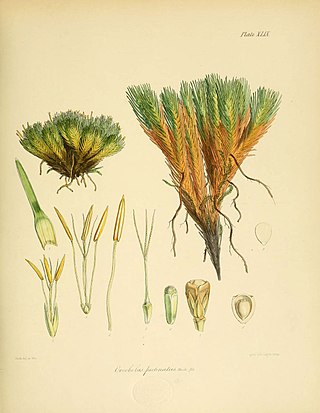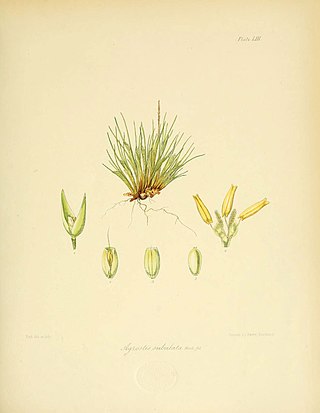
Rostkovia is a genus of flowering plants in the family Juncaceae. It was described in 1809.
Tussock grassland is a form of open grassland that is dominated by tussock grasses. It is common in some temperate grasslands, savannas, and shrublands ecoregions of the Southern Hemisphere. Tussock grasslands are usually typified by low rainfall and poor soils in which few plants other than hardy tussock grasses can flourish. They are predominantly populated by tufted grasses of the genera Agrostis, Andropogon, Chionochloa, Deschampsia, Festuca, Koeleria, Pentameris and Poa. The grasslands are found in New Zealand, Australia, Argentina, temperate areas of southern and eastern Africa, and some subantarctic islands.

Sporobolus virginicus, known by numerous common names including seashore dropseed, marine couch, sand couch, salt couch grass, saltwater couch, coastal rat-tail grass, and nioaka, is a species of grass with a wide distribution.

Acaena magellanica, commonly called buzzy burr or greater burnet, is a species of flowering plant whose range includes the southern tip of South America and many subantarctic islands.

Poa foliosa is a species of tussock grass commonly known as muttonbird poa. It is native to the subantarctic islands of New Zealand and Australia.

Luzula crinita is a species of flowering plant in the rush family that is native to the subantarctic islands of New Zealand and Australia. The specific epithet comes from the Latin crinitus, with reference to the leaves.
Ranunculus crassipes is a small flowering plant in the buttercup or crowfoot family Ranunculaceae that is native to the subantarctic region. The specific epithet comes from the Latin and refers to the plant's thicker and more succulent form compared to the closely related R. biternatus.

Poa cookii, sometimes called Cook's tussock-grass or bluegrass, is a species of tussock grass native to various subantarctic islands. The specific epithet honours British explorer James Cook who visited the Kerguelen Islands in 1776.
Festuca contracta, commonly known as tufted fescue or land tussac, is a species of true grass (Poaceae). It is native to many subantarctic islands in, and the coasts bordering, the Southern Ocean. The specific epithet comes from the Latin contractus, with reference to the inflorescence.

Juncus scheuchzerioides is a species of rush variously called short rush or greater rush. It has an Antarctic circumpolar distribution and is native to many subantarctic islands in, and on the regions bordering, the Southern Ocean.

Coprosma perpusilla, commonly known as creeping coprosma, is a species of flowering plant in the family Rubiaceae. It is found in Australia, New Zealand and on some subantarctic islands. The specific epithet comes from the Latin per (very) and pusillus, referring to the growth habit.

Leptinella plumosa is a small flowering plant in the daisy family. It is a circumantarctic species found on many subantarctic islands in the Southern Ocean. The specific epithet comes from the Latin for “feathery”, referring to the form of the leaves.
Poa kerguelensis is a species of tussock grass native to various subantarctic islands. The specific epithet refers to the type locality – the Kerguelen Islands.

Acaena minor is a species of flowering plant whose range is confined to Australia's subantarctic Macquarie Island and to New Zealand's Campbell and Auckland Islands in the Southern Ocean.

Galium antarcticum, commonly known as Antarctic bedstraw or subantarctic bedstraw, is a species of flowering plant in the coffee family. It has a largely subantarctic range.

Lachnagrostis billardierei, commonly known as coast blown-grass or sand wind grass, is a species of plant in the true grass family. The genus name means “woolly agrostis” with reference to the closely related genus Agrostis; the specific epithet billardierei honours French botanist Jacques Labillardière (1755-1834).

Juncus antarcticus, also known as dwarf rush, is a flowering plant species in the rush family Juncaceae, native to New Zealand and Australia.

Oreobolus pectinatus is a species of flowering plant in the sedge family that is native to the subantarctic islands, and to the North and South Islands of New Zealand. The specific epithet derives from the Latin, pectin/pectinis,, and refers to the leaves.

Agrostis subulata is a grass, which grows only on Campbell Island and on Antipodes Island in New Zealand.

Megaherbs are a group of herbaceous wildflowers growing in the New Zealand subantarctic islands and on the other subantarctic islands. They are characterised by their great size, with huge leaves and very large and often unusually coloured flowers, which have evolved as an adaptation to the harsh weather conditions on the islands. They suffer from overgrazing due to introduced mammals.
















